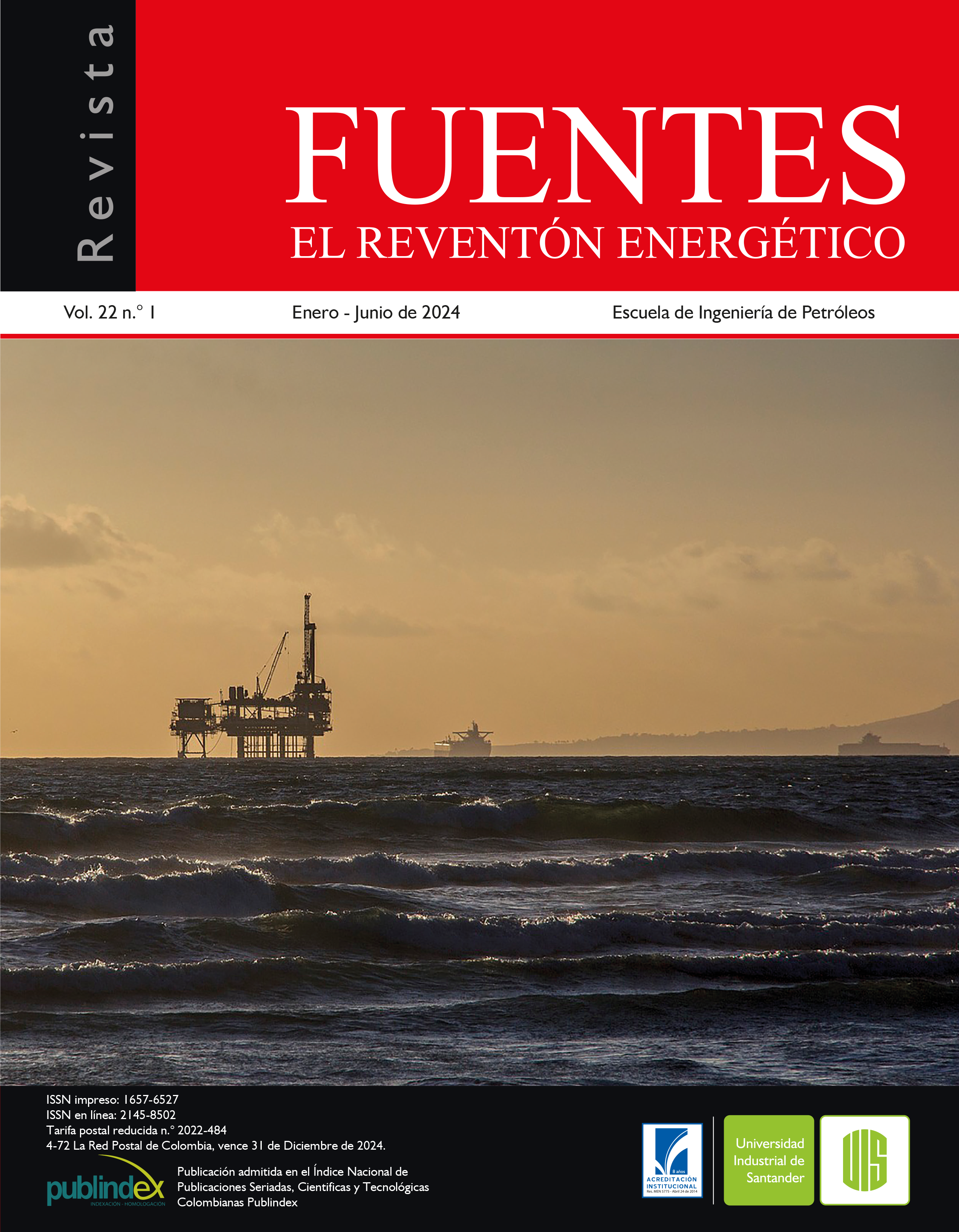Published 2024-09-20
Keywords
- Turbine flowmeter,
- Computational Fluid Dynamics,
- Blade Element Theory,
- Cascade effect,
- Liquefied Petroleum Gas
How to Cite
Copyright (c) 2024 Fuentes, el reventón energético

This work is licensed under a Creative Commons Attribution 4.0 International License.
Abstract
Turbine flowmeters are widely applied to quantify transferred amounts of liquid products due to their accuracy and large operational range. The development of mathematical tools is important to analyze and improve predictions of such meters behavior. Most turbine flowmeters have several blades, becoming the determination of lift and drag coefficients still a challenge. This makes the cascade effect indeed relevant, without which the performance of the turbine can be overestimated by the integral
method Blade Element Theory (BET). Hence, the present work proposes a new cascade correction into the BET model to predict the hydrodynamic behavior of turbine flowmeters applied to Liquefied Petroleum Gas (LPG). The proposed model calculates a correction to the cascade effect on an annular section of the rotor, in order to accurately predict lift and drag coefficients at each blade section. Operational parameters of the studied axial turbine meter are obtained from computational modeling and compared to field data of an existent measurement system for several operating conditions. For this analysis, computational fluid dynamics (CFD) techniques are employed. To validate the CFD model, computational results are compared to in-situ data acquired during the regular operation of the measurement system. As a result, the study indicates that the turbine flowmeter performance can be predicted by the proposed model based on BET, in which the field results of angular velocity and linearity can be precisely estimated.
Downloads
References
- American Petroleum Institute. (2005). Chapter 5.3. Measurement of Liquid Hydrocarbons by Turbine Meters. En: Manual of Petroleum Measurement Standards. (5th ed.). API Publications.
- Andriotis, A., Gavaises, M., Arcoumanis, C. (2008). Vortex flow and cavitation in diesel injector nozzles. Journal of Fluid Mechanics, 610, 195-215. https://doi.org/10.1017/S0022112008002668
- Baker, R.C. (1991). Turbine and related flowmeters: I. Industrial practice. Flow Measurement and Instrumentation, 2(3), 147-161. https://doi.org/10.1016/0955-5986(91)90027-O
- Baker, R.C. (1993). Turbine flowmeters: II. theoretical and experimental published information. Flow Measurement and Instrumentation, 4(3), 123-144. https://doi.org/10.1016/0955-5986(93)90048-N
- Barajas Herrera, E. J., Pérez, J. C., Barrero, J. G., Roncansio, R., & Luque Ortiz, I. (2006). Desarrollo e implementación de computadores de flujo. Fuentes, El reventón energético, 4(1). https://revistas.uis.edu.co/index.php/revistafuentes/article/view/973
- Brennen, C.E. (2016). Internet Book on Fluid Mechanics. Dankat Publishing. http://brennen.caltech.edu/fluidbook/
- Caldas, A., Caldas, A., Dos Santos, C., Ochoa, A., Cezar, K., Michima, P. (2020). Design, development and construction of hall effect-based turbine meter type to measure flow in low-cost lithium bromide salt: Proposed flowmeter and first results. International Journal of Refrigeration, 112, 240-250. https://doi.org/10.1016/j.ijrefrig.2020.01.002
- Daniel Measurement and Control, Inc. 2005. Daniel UMB Turbine meter. Installation and Operation manual. Part Number 3-9008-501. Revision B. Houston, Texas.
- Dzemic, Z., Sirok, B., & Bizjan, B. (2018). Turbine flowmeter response to transitional flow regimes. Flow Measurement and Instrumentation, 59, 18-22. https://doi.org/10.1016/j.flowmeasinst.2017.11.006
- Fagbenro, K. A. (2013). Cascade Effects on Circular Arc Airfoils for Windmill Analysis [Master’s thesis, University of Calgary, Calgary, Canada] https://doi.org/10.11575/PRISM/25220
- Guo, S., Sun, L., Zhang, T., Yang,W., & Yang, Z. (2013). Analysis of viscosity effect on turbine flowmeter performance based on experiments and CFD simulations. Flow Measurement and Instrumentation, 34, 42-52. https://doi.org/10.1016/j.flowmeasinst.2013.07.016
- Hansen, M. (2015). Aerodynamics of wind turbines. (3ra ed.). Routledge.
- Hariri, S., Hashemabadi, S.H., Noroozi, S., Rostami, A. (2015). Analysis of operational parameters, distorted flow and damaged blade effects on accuracy of industrial crude oil turbine flow meter by CFD techniques. Journal of Petroleum Science and Engineering, 127, 318-328. https://doi.org/10.1016/j.petrol.2015.01.010
- Ji, B., Luo, X., Arndt, R.E., & Wu, Y. (2014). Numerical simulation of three dimensional cavitation shedding dynamics with special emphasis on cavitation-vortex interaction. Ocean Engineering, 87, 64-77. https://doi.org/10.1016/j.oceaneng.2014.05.005
- Laws, N.D., & Epps, B.P. (2016). Hydrokinetic energy conversion: Technology, research, and outlook. Renewable and Sustainable Energy Reviews, 57, 1245-1259. https://doi.org/10.1016/j.rser.2015.12.189
- Limacher, E., Morton, C., & Wood, D. (2016). On the trajectory of leading-edge vortices under the influence of coriolis acceleration. Journal of Fluid Mechanics, 800, R1. https://doi.org/10.1017/jfm.2016.395
- Limacher, E., & Rival, D.E. (2015). On the distribution of leading-edge vortex circulation in samara-like flight. Journal of Fluid Mechanics, 776, 316-333. https://doi.org/10.1017/jfm.2015.279
- Moreira, J.L., Mesquita, A.L., Araujo, L.F., Galhardo, M.A., Vaz, J.R., & Pinho, J.T. (2020). Experimental investigation of drivetrain resistance applied to small wind turbines. Renewable Energy, 153, 324-333. https://doi.org/10.1016/j.renene.2020.02.014
- Salami, L.A. (1984). Effect of upstream velocity profile and integral flow straighteners on turbine flowmeters. International Journal of Heat and Fluid Flow, 5(3), 155-165. https://doi.org/10.1016/0142-727X(84)90073-0
- Saboohi, Z., Sorkhkhah, S., & Shakeri, H. (2015). Developing a model for prediction of helical turbine flowmeter performance using CFD. Flow Measurement and Instrumentation, 42, 47-57. https://doi.org/10.1016/j.flowmeasinst.2014.12.009
- Selig, M.S., Guglielmo, J.J., Broeren, A.P., & Giguere, P. (1995). Summary of Low-Speed Airfoil Data. (Vol. 1). SoarTech Publications.
- Rio Vaz, D.A.T.D., Vaz, J.R.P., Silva, P.A.S.F. (2018). An approach for the optimization of diffuser-augmented hydrokinetic blades free of cavitation. Energy for Sustainable Development, 45, 142-149. https://doi.org/10.1016/j.esd.2018.06.002
- Vaz, J. R., & Wood, D. H. (2016). Aerodynamic optimization of the blades of diffuser-augmented wind turbines. Energy Conversion and Management, 123, 35-45. https://doi.org/10.1016/j.enconman.2016.06.015
- Vaz, J.R., Wood, D.H., Bhattacharjee, D., & Lins, E.F. (2018). Drivetrain resistance and starting performance of a small wind turbine. Renewable energy, 117, 509-519. https://doi.org/10.1016/j.renene.2017.10.071
- Wang, Y., Li, H., Liu, X., Li, L., Huang, C., & Hu, J. (2020). A new method of measuring the oil-airwater three-phase flow rate. Chemical Engineering Communications, 207(1), 1-16. https://doi.org/10.1080/00986445.2016.1246438
- Wood, D. (2011). Small wind turbines. In: Advances in wind energy conversion technology. (pp. 195-211). Springer. https://doi.org/10.1007/978-3-540-88258-9
- Xu, Y. (1992a). Calculation of the flow around turbine flowmeter blades. Flow Measurement and Instrumentation, 3(1), 25-35. https://doi.org/10.1016/0955-5986(92)90013-U
- Xu, Y. (1992b). A model for the prediction of turbine flowmeter performance. Flow Measurement and Instrumentation, 3(1): 37-43. https://doi.org/10.1016/0955-5986(92)90014-V
